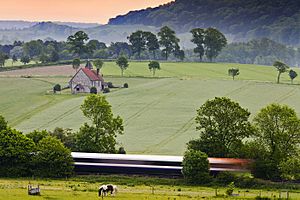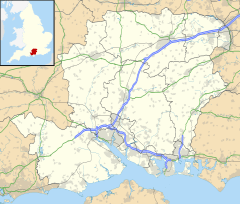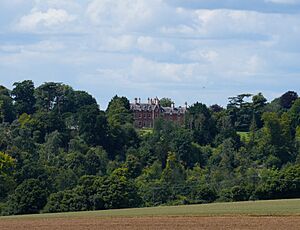Idsworth facts for kids
Quick facts for kids Idsworth |
|
|---|---|
 A Train passing St Hubert's church |
|
| OS grid reference | SU741142 |
| Civil parish | |
| District |
|
| Shire county | |
| Region | |
| Country | England |
| Sovereign state | United Kingdom |
| Post town | Waterlooville |
| Postcode district | PO8 |
| Police | Hampshire |
| Fire | Hampshire |
| Ambulance | South Central |
| EU Parliament | South East England |
Idsworth is a small, quiet village (sometimes called a hamlet) located in Hampshire, England. It's part of the South Downs National Park, a beautiful area of rolling hills. This historic place has roots going all the way back to the Saxons in the Middle Ages. Later, it was an important center for the Normans.
Contents
Exploring Idsworth: A Historic Village
Idsworth is found in a small valley. It is about 1 mile (1.5 km) north of Finchdean, which used to be a larger village connected to Idsworth. It is also 2.3 miles (3.6 km) east of Horndean. The area shares a long border with West Sussex.
What is Idsworth House?
Idsworth is also home to Idsworth House. This large building was constructed around 1850. It was designed by a famous architect named William Burn. In 1977, the house was changed into apartments where people now live.
Discover St Hubert's Chapel
The most famous building in Idsworth is St Huberts Chapel. This church is very old, dating back to the 10th century! It is the only place of worship in the area for the Church of England.
Inside the chapel, you can see amazing mediaeval paintings. These old artworks are on the north wall and around the altar window on the east wall. The church is often called "the little church in the field." It is a peaceful spot for people who enjoy walking on public footpaths.
Idsworth's Past: A Look at Its History
Idsworth used to be a small part of a larger parish called Chalton. In 1866, Idsworth became its own separate civil parish. A civil parish is a local area with its own council.
However, on April 1, 1932, the Idsworth parish was combined with another area to form Rowlands Castle. In 1931, before this change, the Idsworth parish had a population of 538 people.
Getting Around Idsworth
The closest railway station to Idsworth is at Rowlands Castle. It is about 2.1 miles (3.3 km) south of the village.



